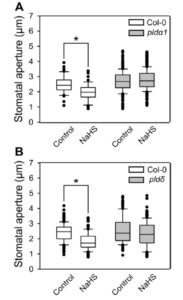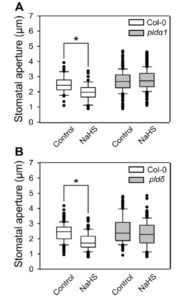Hydrogen Sulfide’s Role in Stomatal Closure

 Hydrogen sulfide (H2S) is an important gaseous signaling molecule in plants that participates in stress responses, development, and stomatal closure. In plants, H2S is enzymatically produced by cysteine desulfhydrase in the catalyzed conversion of cysteine to pyruvate, H2S, and NH3+. In Arabidopsis thaliana, the cytosolic protein DES1 was recently characterized as a novel L-cysteine desulfhydrase. DES1 is involved in plant response to heavy metal stress, immunity, autophagy, and stomatal closure. Although DES1 does not account for all L-cysteine desulfhydrase activity, previous studies have shown that DES1 activity is required for ABA-dependent stomatal closure, and DES1 acts early in ABA-mediated signal transduction. Scuffi et al. (10.1104/pp.17.01636) have combined genetic and pharmacological approaches to shed further light on the involvement of H2S in stomatal closure in Arabidopsis. In particular, they have tested the interplay between H2S and other second messengers of the guard cell signaling network, such as hydrogen peroxide (H2O2) and phospholipase D (PLD)-derived phosphatidic acid (PA). In plants, PA is generated via phospholipase C activity in concert with diacylglycerol kinase (DGK), or directly through hydrolysis of structural lipids by PLD. PA has emerged as a key player in plant signaling. The authors present evidence that H2S stimulates H2O2 production in Arabidopsis guard cells and that two NADPH oxidase isoforms are required for H2S-induced stomatal closure. Additionally, the authors studied the interplay between H2S and PLD activity in the regulation of reactive oxygen species production and stomatal movement. The PLDα1 and PLDδ isoforms were required for H2S-induced stomatal closure, and most of the H2S-dependent H2O2 production required the activity of PLDα1. Finally, the authors also present evidence that H2S induces increases in the PLDδ-derived levels of PA in guard cells. In toto, these results reveal the involvement of H2S in the signaling network that controls stomatal closure, and suggest that H2S regulates the activities NADPH oxidases and PLD in guard cells.
Hydrogen sulfide (H2S) is an important gaseous signaling molecule in plants that participates in stress responses, development, and stomatal closure. In plants, H2S is enzymatically produced by cysteine desulfhydrase in the catalyzed conversion of cysteine to pyruvate, H2S, and NH3+. In Arabidopsis thaliana, the cytosolic protein DES1 was recently characterized as a novel L-cysteine desulfhydrase. DES1 is involved in plant response to heavy metal stress, immunity, autophagy, and stomatal closure. Although DES1 does not account for all L-cysteine desulfhydrase activity, previous studies have shown that DES1 activity is required for ABA-dependent stomatal closure, and DES1 acts early in ABA-mediated signal transduction. Scuffi et al. (10.1104/pp.17.01636) have combined genetic and pharmacological approaches to shed further light on the involvement of H2S in stomatal closure in Arabidopsis. In particular, they have tested the interplay between H2S and other second messengers of the guard cell signaling network, such as hydrogen peroxide (H2O2) and phospholipase D (PLD)-derived phosphatidic acid (PA). In plants, PA is generated via phospholipase C activity in concert with diacylglycerol kinase (DGK), or directly through hydrolysis of structural lipids by PLD. PA has emerged as a key player in plant signaling. The authors present evidence that H2S stimulates H2O2 production in Arabidopsis guard cells and that two NADPH oxidase isoforms are required for H2S-induced stomatal closure. Additionally, the authors studied the interplay between H2S and PLD activity in the regulation of reactive oxygen species production and stomatal movement. The PLDα1 and PLDδ isoforms were required for H2S-induced stomatal closure, and most of the H2S-dependent H2O2 production required the activity of PLDα1. Finally, the authors also present evidence that H2S induces increases in the PLDδ-derived levels of PA in guard cells. In toto, these results reveal the involvement of H2S in the signaling network that controls stomatal closure, and suggest that H2S regulates the activities NADPH oxidases and PLD in guard cells.



